Jarrod And Me And The Station Of Willoughby
by Mike Bowen
Reprinted from "Crown Jewels of the Wire", April 1990, page 13
Six years ago, while I was on leave of absence from the Navy, my son Jarrod
and I decided to take a hike along an old section of railroad lines here in
northeast Ohio. Only a few months earlier, we had found our first insulator (a
Hemingray 42) along a line outside of Jacksonville, Florida, where we were
stationed.
As we walked along searching for downed poles and crossarms in the
thick brush, I discovered an overgrown road leading downhill into a large, deep
valley. As we investigated, we found the remains of an old power and signal
line heaped in piles. Within the boundaries of the poles we found pieces of CD
121's, 114's, 115's and a lot of high power ceramic insulators.
As our
excitement increased with each discovery, I realized we had walked nearly to the
valley floor. To explain the feelings we felt, as we gazed at the old building
foundations, the piles of crossbeams, would be to describe the emotions of an
archeologist finding the ruins of ancient Troy or an explorer treading on
unknown lands. All around us were the impressions of age and decay, forgotten
and timeless artifacts of a bygone era.
We energetically explored the ancient
foundation and discovered a lone wall still standing at the foot of the
hillside. On the wall, set within the crumbling mortar and brick, was a rusted
cast iron plaque with a relief of a man at work and a date (which we determined
to be 1893). Also at the base of the wall we found many pieces of other
insulators and an incredible new find -- the E.S.B. chloride accumulators in dark
green and light blue. As we walked around the overgrown foundations, thrilled
with our discoveries, I realized the ground was literally covered with
thousands of broken insulators, in many styles and colors. We even found the
"Whatzit" pictured in Milholland's Bicentennial Edition of Most About
Glass Insulators. In the valley, the trees had dropped a deep accumulation of
leaves and limbs, and we decided to return the next day with a few yard tools.
As we related our amazing story to our family, neither of us stopped talking for
several hours.
In the six years since our discovery, my son and I and a few
close friends and relatives have returned many times to the site. We mapped the
area, staked out certain foundations, plotted and traced the old telephone lines. The site
had all the eager emotions and atmosphere of an archeological dig in Tanzania!
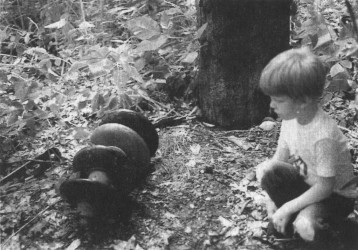
Jarrod is studying the high voltage, ceramic insulators (above)
and the
cross-beams (below) that led us on a trail to the valley floor.
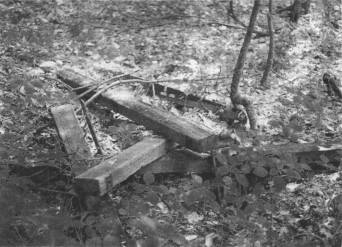
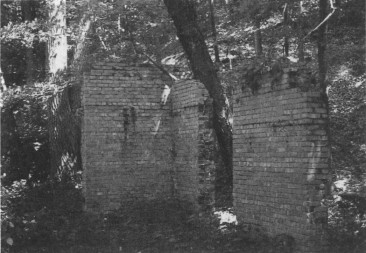
The only wall left standing of a building in the floor of the valley. As I
stood
in the doorway of the ruins, I wondered what the building had been.
(See
1920 photograph of power house later in the article.)
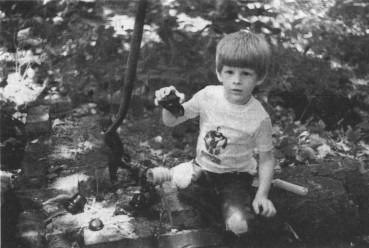
Jarrod sorts through the many styles and pieces that we found covering the
ground.
We uncovered many pieces of different insulators lying just a few inches beneath
the leaves and soil. We dug for and found a few nice CD 121's at the base of a
decayed pole and following the contour of the valley floor, paced off the
distance to the next pole. Our diligence paid off, for we removed from the earth
several "AM. TEL & TEL. CO." (CD 190/191 and CD 121). We have dug
up in mint and near mint:
CD 121 Hemingray No.16
CD 115 Hemingray 10
CD 113 Hemingray 12
CD 121
Brookfield
CD 106 Hemingray 9
and the E.S.B. Chloride Accumulators in emerald
green.
In pieces we found ---
E.S.B. in ice blue;
The "Whatzit";
CD 257
in ice blue;
CD 196;
CD 301 OHIO
CD 303;
CD 121 in jade;
CD 160;
CD 151 in an
electric blue;
CD 210;
CD 153 in green.
Of all the folks I've been exploring
with, my son Jarrod and I have had the most enjoyable times together. Since all
young boys are prone to ask questions that require valid answers, we know that
our discoveries needed further explanations. What was down there? How long ago
was it destroyed? Why so many insulators?
The research spanned the better part
of the winter months and really tied things together for us. I started out by
talking to a few of the older folks in our area. Although the building
demolition and subsequent dump were remembered, what the site was still remained
unclear. Could it have been a power station?
Certain things proved this to be
the case -- a large power line trees and crossbeam piles, all radiating from the
valley (some at a point more that 1/2 mile from the site). Many stacks of high
voltage porcelain insulators, and access to the then major railroad for coal
delivery as well as the Chagrin River for water use.
My research revealed we had
discovered the ruins of the Cleveland, Pennsylvania and Erie railroad power
station. It was built to serve the C.P.&E.R.R. and a later Interurban
Trolley system which ran from Cleveland to its far eastern suburbs in the early
1900's. The power station was built around 1893 and was the hub of a great
railroad and trolley system in early Willoughby and nearby cities of that era. It
was shut down by the early 1920's and demolished in 1926-28. Apparently the site
was used as a dump for electrical glass, slag and odd industrial junk. This may
account for the occurrence of so many different styles of insulators.
The
remains were not as scattered as I once thought, because less than a mile away,
across from the municipal land fill in Willoughby, there is a fenced in two acre
lot that has been there for the last 65 years. It contains much of the brick
from the old station, the ancient coal fired boilers, the coal chutes and cars,
all kinds of bygone industrial gears, pulleys, levers, structural parts, and many rotting barrels (I suspect they
contained something caustic years ago -- for everything down grade of the
barrels, like trees and vegetation, is dead and brown), and a structure that may
contain the power station generators and electrical items. Everything has been
sitting in place for a very long time; as evidenced by the old 12 x 12 wooden
beams that are nearly gone now.
Our search has never stopped, and this summer we
may find more insulators since we plan to increase the dig if we can get
permission from the present land owners. The site has been visited by a person
from the Western Reserve Historical Society, but there really isn't enough to
interest anyone but a few lucky insulator hounds!
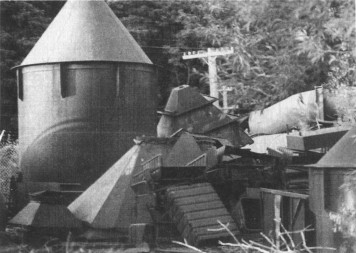
About a half mile away, we found what was left
of the internal workings of
the power station.
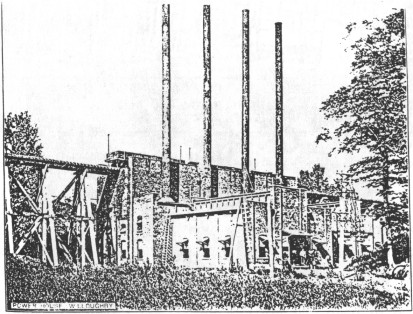
This photo was taken of the Willoughby Power House about 70 years ago.
A man
stands in the doorway where I had stood. I used the pictured poles
to trace the
electric lines, and many telephone and low voltage
insulators were found at the
base of the decayed poles.
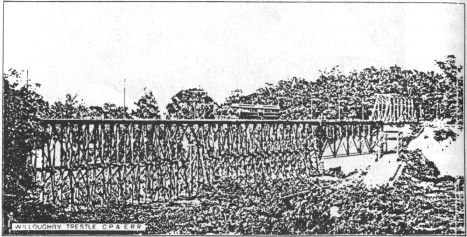
The Willoughby Trestle of the C.P.& E.R.R. The Interurban trolley
was the
reason the power house was built. ft was closed when
roadways and automobiles
replaced the trolley line.
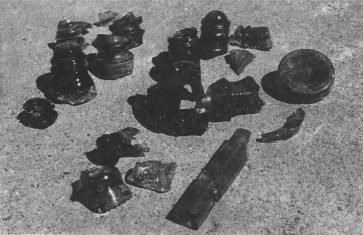
Many of the insulators are in pieces, but the search will continue.
The 7-1/4" bar in an olive green glass was also dug at the site. It was
used as
a sleeve to fit over the top ledge of a battery jar.
| 